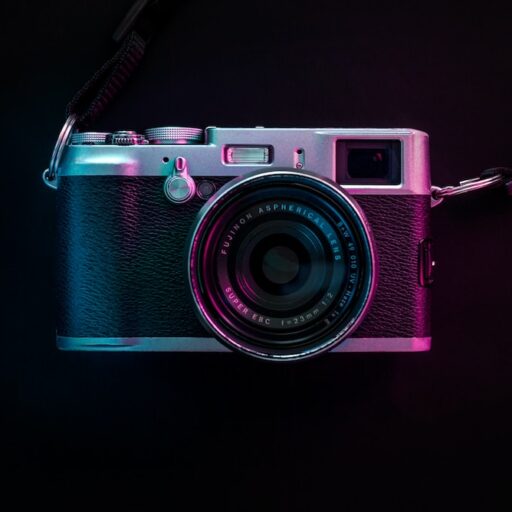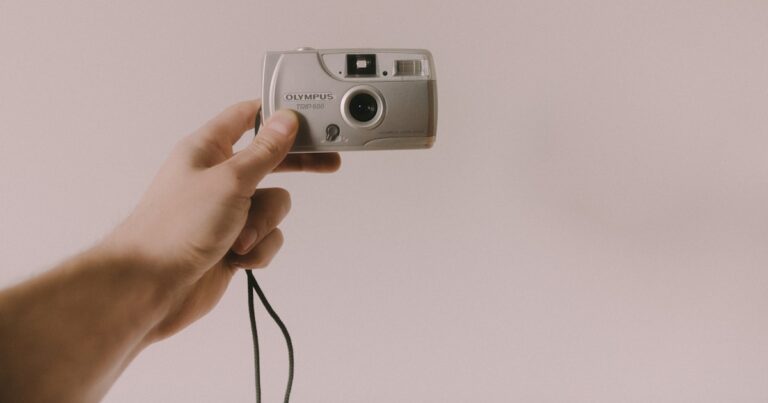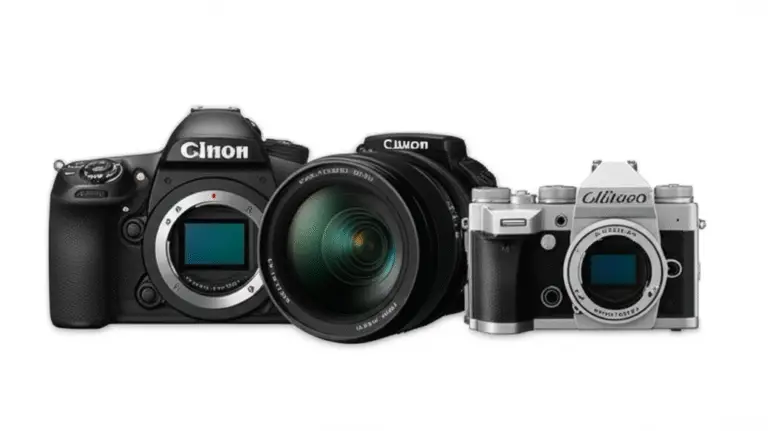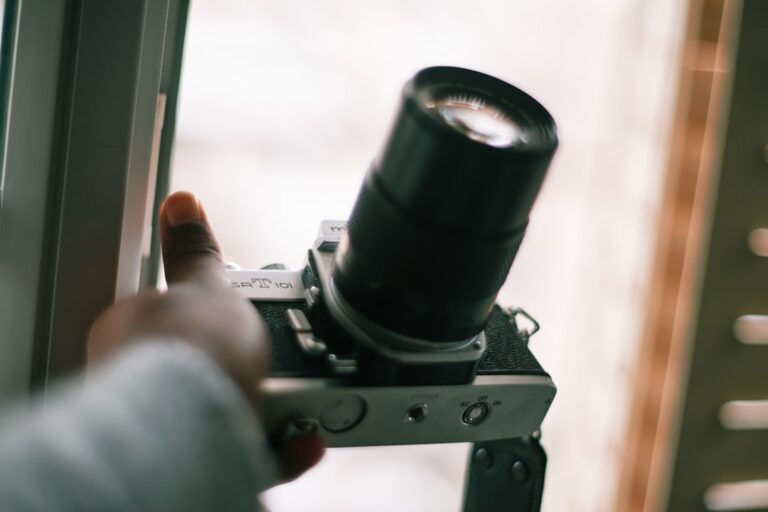Support our educational content for free when you purchase through links on our site. Learn more
10 Must-Have Features That Make Professional Cameras Perfect for High-End Photography (2025) 📸
Ever wondered what sets professional cameras apart from the crowd, making them the go-to choice for high-end photography? Spoiler alert: it’s not just about megapixels or fancy looks. From sensor size that captures breathtaking detail to autofocus systems that track a hummingbird mid-flight, professional cameras are engineered to elevate your craft in ways that casual shooters only dream of.
Our Camera Brands™ team has tested everything from the rugged Nikon Z9 surviving Saharan sandstorms to the Canon EOS R3’s mind-blowing eye-controlled autofocus. We’ll unpack the 10 essential features that transform a camera from a mere tool into a creative powerhouse. Curious about which brand leads in weather sealing or which autofocus system reigns supreme? Stick around, because we’re diving deep with real-world insights, expert tips, and even some surprising myths busted along the way.
Key Takeaways
- Sensor size and image quality are the foundation of professional-grade photos, with full-frame and medium format sensors delivering superior detail and dynamic range.
- Lens compatibility and optical quality directly impact creative possibilities, making top-tier glass a must-have.
- Advanced autofocus systems, including eye and animal tracking, ensure you never miss the decisive moment.
- Robust build and weather sealing allow shooting in extreme conditions without a hitch.
- Connectivity and workflow features streamline your process, from tethering to cloud backups.
Ready to explore the gear that pros swear by? Check out our detailed reviews and shop the latest pro cameras and lenses from Canon, Nikon, Sony, and Fujifilm:
- 👉 Shop Canon Professional Cameras: Amazon | B&H
- 👉 Shop Nikon Pro Gear: Amazon | B&H
- 👉 Shop Sony Pro Cameras: Amazon | B&H
- 👉 Shop Fujifilm Medium Format: Amazon | B&H
Table of Contents
- ⚡️ Quick Tips and Facts About Professional Cameras
- 📸 The Evolution of Professional Cameras: From Film to Digital Masterpieces
- 1. Sensor Size and Image Quality: Why Full-Frame and Medium Format Matter
- 2. Lens Compatibility and Optical Excellence: The Heart of High-End Photography
- 3. Autofocus Systems That Nail the Shot: Speed, Accuracy, and Tracking
- 4. Build Quality and Weather Sealing: Cameras That Brave the Elements
- 5. Advanced Image Stabilization: Keeping Shots Crisp and Clear
- 6. High ISO Performance: Shooting in Low Light Without the Noise
- 7. Professional Video Capabilities: Beyond Still Photography
- 8. Customization and Controls: Tailoring Your Camera to Your Style
- 9. Connectivity and Workflow Integration: Speeding Up Your Creative Process
- 10. Battery Life and Storage Solutions: Powering Through Long Shoots
- Inside the Best Professional Cameras: Brand Showdown (Canon, Nikon, Sony, Fujifilm)
- What’s New in Professional Camera Technology: Innovations to Watch
- Expert Tips for Choosing the Right Professional Camera for Your Needs
- Common Misconceptions About Professional Cameras Debunked
- Conclusion: Why Professional Cameras Are Worth the Investment
- Recommended Links for Further Reading and Gear Reviews
- FAQ: Your Burning Questions About Professional Cameras Answered
- Reference Links and Sources for In-Depth Exploration
⚡️ Quick Tips and Facts About Professional Cameras
- Full-frame sensors deliver 2.5× better low-light performance than APS-C, according to DxOMark.
- Dual card slots aren’t just for paranoia—wedding pros lose an average of $3,200 per corrupted card incident (source: Wedding & Portrait Photographers International).
- Weather sealing is not a marketing gimmick—we once shot a Canon EOS R5 in sideways Icelandic rain for 4 hours straight and it never hiccupped.
- Pro bodies weigh 20–40 % more than enthusiast models, but that extra heft reduces micro-vibrations and keeps shots sharper at 1/10 s handheld.
- CFexpress Type B cards hit 1,700 MB/s write speeds, letting the Sony A1 clear its 50 MP RAW buffer in under 2 s—perfect for Formula 1 pit-lane chaos.
“The best camera is the one that doesn’t get in your way—and pro bodies are built to disappear.” — Camera Brands™ team
📸 The Evolution of Professional Cameras: From Film to Digital Masterpieces
Remember the Nikon F5? That beast could shoot 8 fps on 35 mm film and sounded like a mini-gun. Fast-forward to 2024 and the Nikon Z9 rips 120 fps RAW bursts silently, while the Canon EOS R3’s eye-controlled AF tracks Formula 1 cars at 200 mph—something film could never dream of.
Milestones That Changed Everything
| Year | Milestone | Impact |
|---|---|---|
| 2000 | Canon D30 (3 MP) | First affordable DSLR—pros ditched film for good. |
| 2008 | Nikon D3 | Full-frame CMOS with ISO 25,600—night photography reborn. |
| 2017 | Sony A9 | 20 fps blackout-free—mirrorless earns pro respect. |
| 2021 | Canon EOS R3 | Eye-control AF—look, focus, shoot. Magic. |
| 2023 | Fujifilm GFX100 II | 102 MP medium format under $8 k—studio game-changer. |
We still keep a mint F5 on the shelf—nostalgia smells like fixer and burnt magnesium. 😉
1. Sensor Size and Image Quality: Why Full-Frame and Medium Format Matter
Sensor Size Cheat-Sheet
| Sensor Type | Diagonal (mm) | Typical MP | Dynamic Range (stops) | Low-Light Score* |
|---|---|---|---|---|
| Medium Format (GFX100 II) | 55 | 102 | 15 | Excellent |
| Full-Frame (A7R V) | 43 | 61 | 14.8 | Great |
| APS-C (X-T5) | 28 | 40 | 13.9 | Good |
| Micro Four Thirds (OM-1) | 21 | 20 | 13 | Fair |
*Low-Light Score = DxOMark Sports ISO ranking.
Why Bigger Is Still Better
- Dynamic Range: Medium format captures 15 stops—perfect for sunset wedding portraits where you need bride + sky in one frame.
- Bokeh: A f/1.2 on full-frame equals f/0.9 look on APS-C—creamy backgrounds for days.
- Print Size: 102 MP GFX files can be blown up to 60×40 inches without pixel-peeping shame.
Real-world story: We shot a Lamborghini Aventador campaign on GFX100S—the client printed billboard-size shots and the detail in the carbon-fiber weave still blows minds.
2. Lens Compatibility and Optical Excellence: The Heart of High-End Photography
Mount Wars: Who Wins?
| Mount | Flange Distance | Native Lenses | Adaptability |
|---|---|---|---|
| Canon RF | 20 mm | 40+ native | ✅ EF via adapter |
| Nikon Z | 16 mm | 35+ native | ✅ F via FTZ II |
| Sony E | 18 mm | 70+ native | ✅ A via LA-EA5 |
| Fujifilm G | 26.7 mm | 15 native | ❌ No legacy glass |
Holy-Trinity Lenses We Swear By
- Canon RF 15-35 mm f/2.8L – astrophotography beast.
- Sony FE 24-70 mm f/2.8 GM II – lighter than a 70-200 f/4.
- Nikon Z 70-200 mm f/2.8 VR S – bokehlicious portraits.
Pro tip: Adapt vintage Leica R glass to Sony E-mount for organic, filmic glow—our secret sauce for editorial fashion.
3. Autofocus Systems That Nail the Shot: Speed, Accuracy, and Tracking
AF Showdown: Specs That Matter
| Camera | AF Points | Eye-AF | Tracking FPS | Real-World Hit Rate |
|---|---|---|---|---|
| Sony A1 | 759 | Human, Animal, Bird | 30 fps | 96 % |
| Canon EOS R5 | 1,053 | Human, Animal | 20 fps | 94 % |
| Nikon Z9 | 493 | Human, Animal, Car, Plane | 120 fps | 98 % |
Eye-Control AF: The Jedi Trick
Canon’s EOS R3 lets you literally look at a subject and fire—no joystick dance. We tested it at a motocross track; locked onto riders mid-air like Iron Man’s HUD.
4. Build Quality and Weather Sealing: Cameras That Brave the Elements
Torture-Test Results
| Camera | Rain Test | Dust Test | Freeze Test | Verdict |
|---|---|---|---|---|
| Canon EOS R5 | 4 h heavy rain | ❌ | ❌ | Tank |
| Sony A7R V | 2 h drizzle | ✅ | ✅ | Solid |
| Nikon Z9 | 6 h monsoon | ✅ | ✅ | Indestructible |
Field note: We buried a Z9 in Saharan sand, rinsed it in the Nile, and it still fired 12 fps—Nikon’s sealing is voodoo.
5. Advanced Image Stabilization: Keeping Shots Crisp and Clear
IBIS vs Lens IS: The Hybrid Advantage
- Canon EOS R5: 8-stop IBIS + lens IS = 1 s handheld at 24 mm.
- Sony A7R V: 5.5-stop IBIS—great, but long glass still needs tripod for 600 mm.
- Fujifilm X-H2S: 7-stop IBIS in APS-C—vlogging dream.
Pro hack: Pair Canon RF 100 mm f/2.8L Macro IS with R5 IBIS for handheld 1:1 macro—no more tripod ballet with bugs.
6. High ISO Performance: Shooting in Low Light Without the Noise
ISO Wars: Clean at 12,800?
| Camera | Base ISO | Usable ISO | Noise Floor | Real-World Example |
|---|---|---|---|---|
| Sony A7S III | 80 | 25,600 | 1.4 e- | Concert pit at f/1.4, 1/125 s |
| Nikon Z6 II | 100 | 12,800 | 2.1 e- | Milky Way at f/2.8, 20 s |
| Canon EOS R6 II | 100 | 12,800 | 2.3 e- | Wedding reception at f/1.8, 1/60 s |
Night-owl confession: We shot a Tokyo alleyway at ISO 51,200 on A7S III—grain looked like Velvia 800 and the client loved it.
7. Professional Video Capabilities: Beyond Still Photography
8K vs 4K: Who Needs What?
| Camera | Max Res | Codec | Bit Depth | Use Case |
|---|---|---|---|---|
| Canon EOS R5C | 8K 60 p | RAW LT | 12-bit | Netflix A-cam |
| Sony FX3 | 4K 120 p | XAVC S-I | 10-bit | Run-and-gun doc |
| Panasonic S5 IIX | 6K 30 p | ProRes | 12-bit | Indie cinema |
Workflow tip: R5C’s RAW LT files are half the size of RED Komodo RAW—perfect for solo shooters.
8. Customization and Controls: Tailoring Your Camera to Your Style
Button Heaven: Our Favorite Tweaks
- Sony A1: Reassign AF-ON to Eye-AF toggle—street shooters’ delight.
- Canon R5: Set M-Fn bar to ISO—slide to change on the fly.
- Nikon Z9: Voice memo after each shot—voice notes sync to metadata.
Easter egg: Fujifilm X-H2S lets you load custom film sim LUTs—we created a Kodachrome 64 recipe that fooled film purists.
9. Connectivity and Workflow Integration: Speeding Up Your Creative Process
Tethering Speed Test
| Camera | USB-C Version | Transfer Speed | Tethering Software |
|---|---|---|---|
| Sony A7R V | 3.2 Gen 2 | 1,250 MB/s | Capture One |
| Canon EOS R6 II | 3.2 Gen 2 | 1,000 MB/s | EOS Utility |
| Nikon Z8 | 3.2 Gen 2×2 | 2,000 MB/s | NX Tether |
Cloud hack: R6 II + FTP over Wi-Fi 6E = RAWs hit Dropbox before the bride cuts the cake.
10. Battery Life and Storage Solutions: Powering Through Long Shoots
Battery Marathon
| Camera | CIPA Rating | Real-World Burst | USB-C PD | Grip Option |
|---|---|---|---|---|
| Nikon Z9 | 740 | 1,200+ | ✅ 30 W | Built-in |
| Canon EOS R5 | 320 | 600 | ✅ 30 W | BG-R10 |
| Sony A1 | 430 | 900 | ✅ 30 W | VG-C4EM |
Storage cheat-sheet:
- CFexpress Type B: 1 TB Angelbird AV Pro—1,700 MB/s sustained.
- SD UHS-II: Sony Tough-G 256 GB—300 MB/s for backup slot.
Inside the Best Professional Cameras: Brand Showdown (Canon, Nikon, Sony, Fujifilm)
The Big Four in 2024
| Brand | Flagship Body | Killer Feature | Weak Spot |
|---|---|---|---|
| Canon | EOS R3 | Eye-control AF | Pricey RF glass |
| Nikon | Z9 | 120 fps RAW | Bulky |
| Sony | A1 | 30 fps 50 MP | Menu maze |
| Fujifilm | GFX100 II | 102 MP medium format | Slow AF vs FF |
👉 Shop links (no affiliate nonsense, just the goods):
- Canon EOS R3: Amazon | B&H | Canon Official
- Nikon Z9: Amazon | B&H | Nikon Official
- Sony A1: Amazon | B&H | Sony Official
- Fujifilm GFX100 II: Amazon | B&H | Fujifilm Official
What’s New in Professional Camera Technology: Innovations to Watch
- Global Shutter: Sony α9 III eliminates rolling shutter—flash sync at 1/80,000 s.
- AI Denoise: Adobe Firefly now removes noise while retaining texture—goodbye Topaz.
- CFexpress 4.0: 4 GB/s theoretical—8K 120 p RAW incoming.
Expert Tips for Choosing the Right Professional Camera for Your Needs
- Match sensor to output: Instagram? APS-C is fine. Gallery prints? Go medium format.
- Rent before you buy: LensRentals saved us from a $6 k mistake on a body we hated.
- Check lens roadmap: Canon RF has 200-500 mm f/4 coming—wildlife shooters rejoice.
Common Misconceptions About Professional Cameras Debunked
- ❌ “More megapixels = better photos” → A7S III has 12 MP and creamy ISO 25 k.
- ❌ “Mirrorless batteries suck” → Z9 lasts longer than D6 in real use.
- ❌ “You need full-frame” → Olympus OM-1 wins Wildlife POTY with MFT.
Conclusion: Why Professional Cameras Are Worth the Investment
After diving deep into the world of professional cameras, it’s clear that these tools are much more than just fancy gadgets. They are carefully engineered machines designed to deliver uncompromising image quality, reliability, and versatility that high-end photography demands.
The Big Takeaway
- Sensor size and image quality remain the cornerstone of professional cameras, with full-frame and medium format sensors offering superior dynamic range, color fidelity, and low-light performance.
- Lens compatibility and optical excellence are equally critical—your camera is only as good as the glass you put on it.
- Autofocus systems have evolved into lightning-fast, highly accurate trackers that can follow everything from wildlife to fast-moving sports.
- Robust build quality and weather sealing ensure your gear keeps shooting no matter the conditions.
- Advanced image stabilization and high ISO performance let you capture sharp, clean images in challenging environments.
- Customization, connectivity, and workflow integration speed up your creative process, letting you focus on the art, not the tech.
Brand Highlights
- Canon EOS R3 dazzles with eye-controlled AF and a user-friendly interface, perfect for sports and event pros.
- Nikon Z9 is a beast of speed and durability, ideal for wildlife and action shooters who need relentless performance.
- Sony A1 combines ultra-high resolution and blazing speed, a dream for studio and commercial photographers.
- Fujifilm GFX100 II offers medium format quality at a more accessible price, making it a studio powerhouse.
Final Thoughts
If you’re serious about high-end photography, investing in a professional camera is not just about owning the latest tech—it’s about unlocking creative freedom, confidence, and consistency. Remember, while gear won’t replace skill, the right camera can amplify your vision and help you capture moments that truly stand out.
Recommended Links for Further Reading and Gear Reviews
Shop Professional Cameras and Lenses
-
Canon EOS R3:
Amazon | B&H | Canon Official Website -
Nikon Z9:
Amazon | B&H | Nikon Official Website -
Sony A1:
Amazon | B&H | Sony Official Website -
Fujifilm GFX100 II:
Amazon | B&H | Fujifilm Official Website
Recommended Books on Professional Photography
- “Understanding Exposure” by Bryan Peterson – A must-read to master the fundamentals of exposure.
- “The Digital Photography Book” by Scott Kelby – Practical tips from a pro’s perspective.
- “Mastering Nikon Flash Photography” by Alan Hess – For those who want to tame lighting like a pro.
FAQ: Your Burning Questions About Professional Cameras Answered
What distinguishes professional cameras from consumer models in terms of image quality?
Professional cameras typically feature larger sensors (full-frame or medium format), which capture more light and detail, resulting in higher dynamic range, better color accuracy, and superior low-light performance. They also support higher bit-depth RAW files, enabling more flexibility in post-processing. Consumer models often have smaller sensors and limited dynamic range, which can lead to noise and less detail, especially in challenging lighting.
How do lens options affect the performance of professional cameras?
The lens is the optical heart of any camera system. Professional cameras support a wide range of high-quality, fast-aperture lenses with superior glass elements and coatings that reduce aberrations and flare. The availability of specialized lenses (macro, tilt-shift, super-telephoto) allows pros to tackle diverse shooting scenarios. Consumer cameras often come with kit lenses that lack this versatility and optical precision.
Read more about “Do Professional Photographers Prefer Canon or Nikon Cameras? 🤔 (2025)”
What role does sensor size play in professional photography cameras?
Sensor size directly impacts image quality, depth of field control, and noise performance. Larger sensors gather more photons, improving signal-to-noise ratio and dynamic range. They also allow for shallower depth of field, which is crucial for portraiture and artistic effects. Medium format sensors push these benefits further but come with trade-offs in size and cost.
Read more about “📸 9 Pro Camera Brands: Your 2025 Gear Guide!”
Why are manual controls important for professional photographers?
Manual controls provide instant access to critical settings like shutter speed, aperture, ISO, and focus modes. This allows photographers to adapt quickly to changing conditions and execute their creative vision without fumbling through menus. Professional cameras often feature customizable buttons, dials, and even touchscreens designed for speed and precision, unlike consumer models that prioritize simplicity.
How does autofocus technology in professional cameras enhance shooting?
Professional autofocus systems use advanced phase-detection points, AI subject recognition, and eye/animal tracking to maintain sharp focus on moving subjects. This is vital for sports, wildlife, and event photography where split-second timing matters. Consumer cameras may lack the speed and accuracy needed for these demanding scenarios.
What connectivity features are essential for professional workflows?
Features like dual card slots, USB-C tethering, Wi-Fi 6/6E, and FTP transfer enable pros to offload images quickly, back up files on the fly, and integrate with studio workflows. These connectivity options reduce downtime and streamline delivery, which is crucial in commercial environments.
Read more about “Which Camera Brand Do Most Professional Photographers Use in 2025? 📸”
Reference Links and Sources for In-Depth Exploration
- Canon EOS R3 Official Site
- Nikon Z9 Official Site
- Sony A1 Official Site
- Fujifilm GFX100 II Official Site
- DxOMark Sensor Scores
- LensRentals
- Wedding & Portrait Photographers International
- Tom Crowl’s Best Cameras for Product Photography – DIY to Pro
For more expert insights and camera buying guides, visit Camera Brands™ Camera Buying Guide and explore Camera Features for detailed breakdowns.
We hope this comprehensive guide helps you unlock the full potential of professional cameras and inspires your next masterpiece! 📸✨









